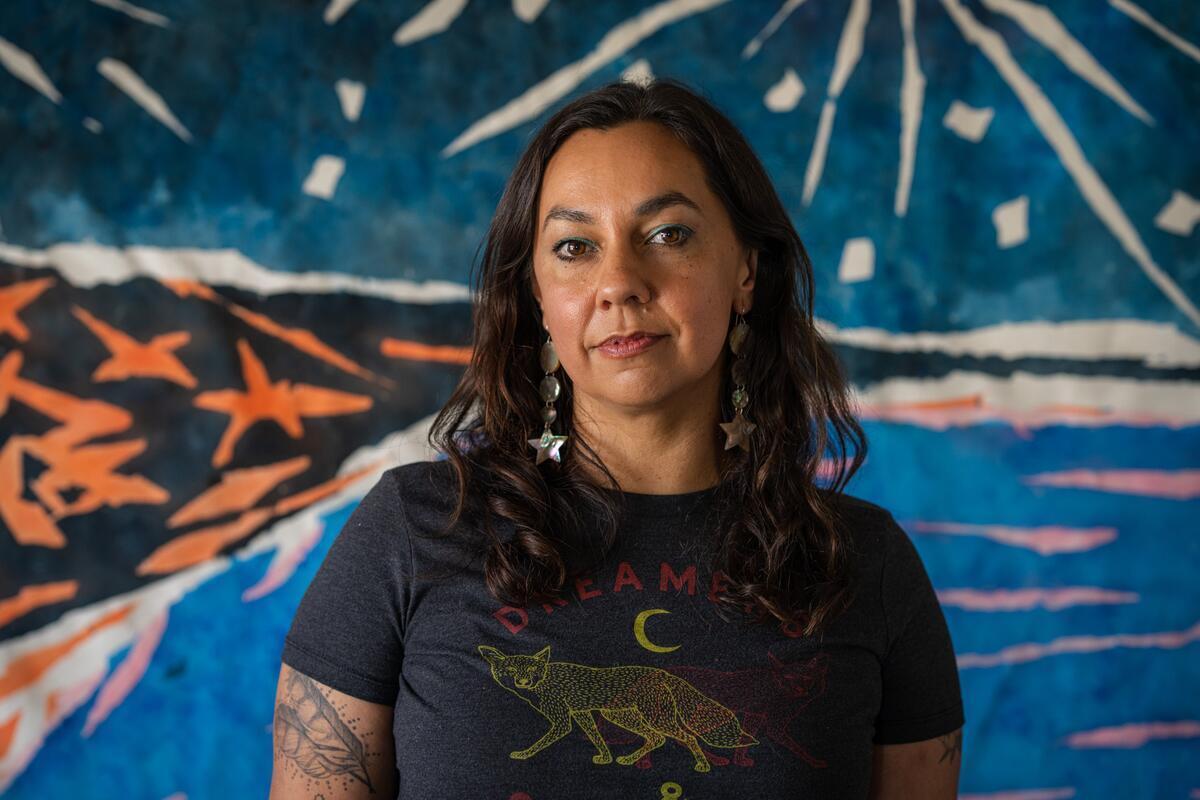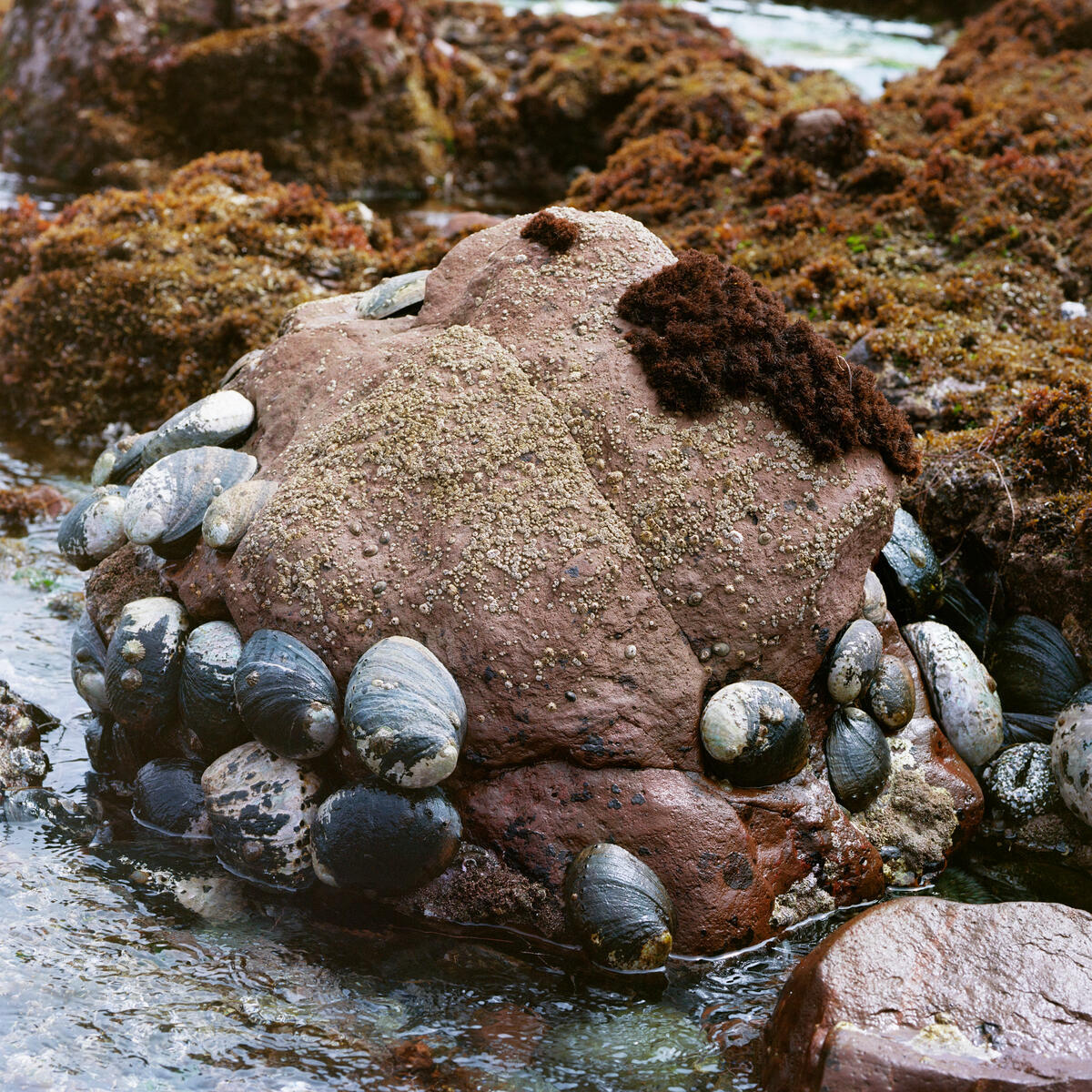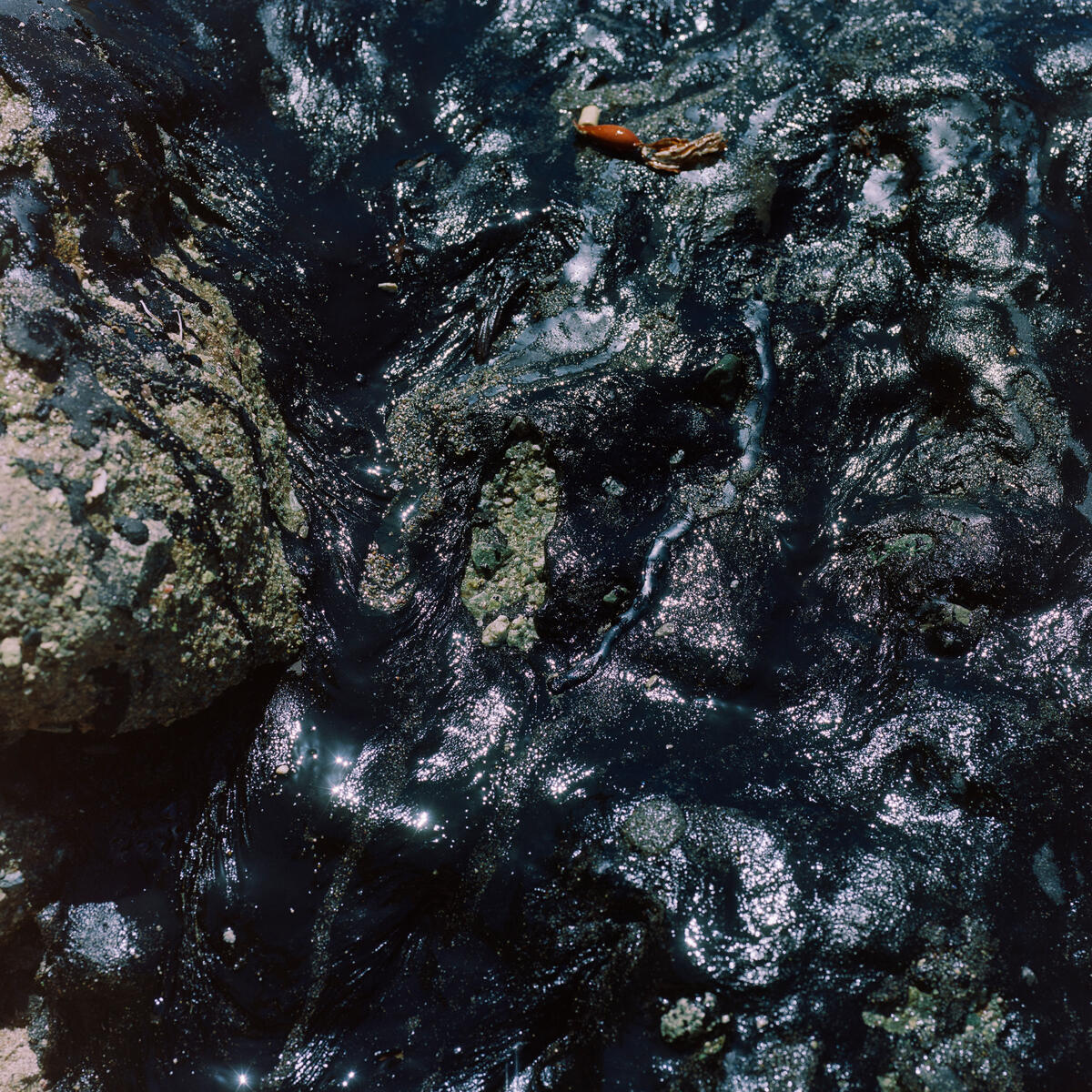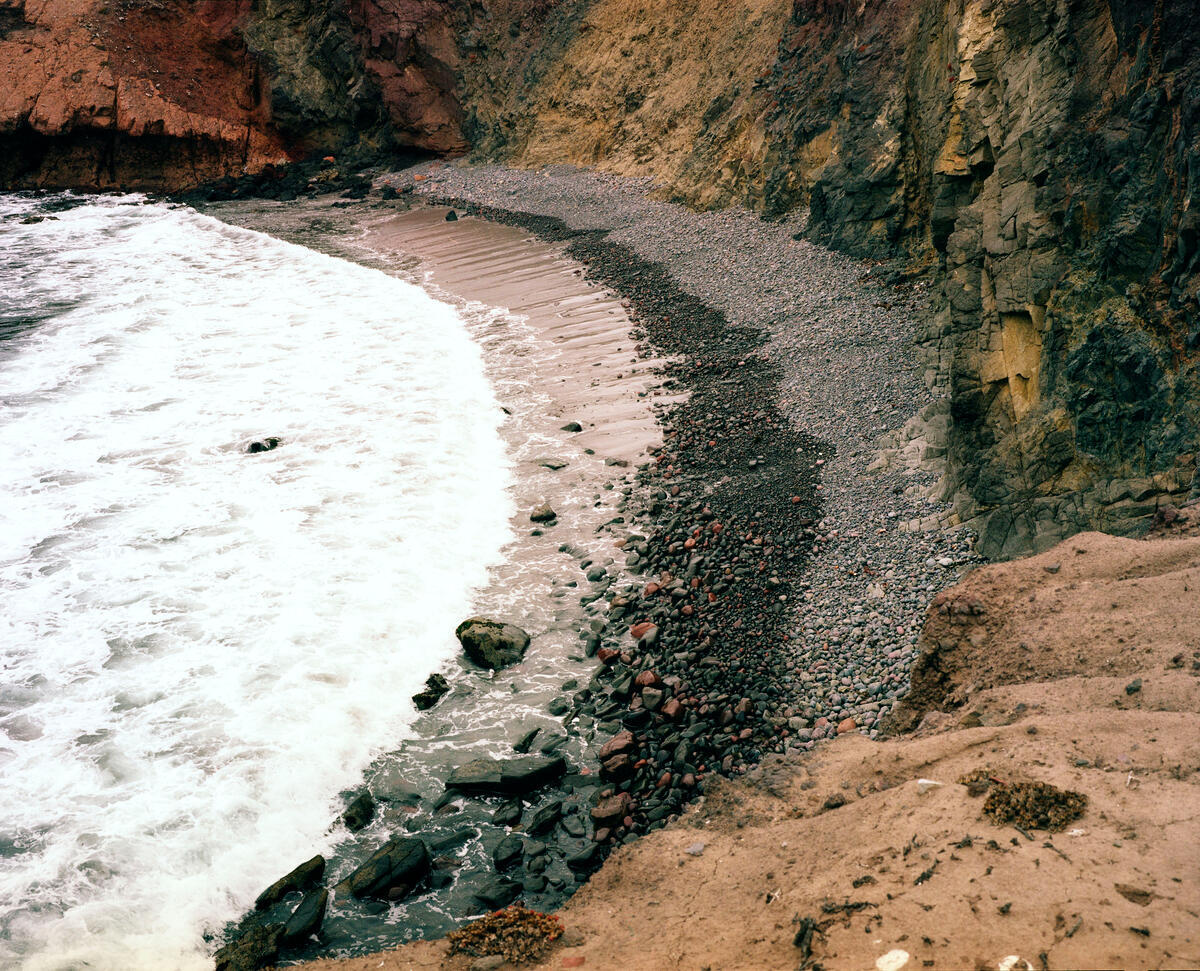
Mercedes Dorame (Tongva, b. 1980), Algae Portal—Shooxar Tukuupar, 2022, inkjet print. | Courtesy of Mercedes Dorame.
In the spring of 2022, Tongva photographer Mercedes Dorame peered down at a tide pool on Santa Cruz Island, roughly 25 miles off the coast of California. Focusing her camera, she captured an image that provides a window into worlds. A pool of crystalline water is framed by rocks covered with algae in rich shades of brown and green. The surrounding area is still wet from the receding ocean, giving the viewer a sense of the ebb and flow of tides and the passage of time. Visible through the water is a microcosm of crushed shells and stones, with small barnacles clinging to a cluster of rocks.
Dorame visited the site during a multiyear artistic project to document Indigenous landscapes on the Channel Islands of Santa Cruz and Santa Catalina. Her photograph Algae Portal—Shooxar Tukuupar (see above) is womblike in its presence, a crucible of life, seemingly ancient and yet exceedingly fragile and ever-changing. For Dorame, an Indigenous artist who grew up in Los Angeles, the experience was disorienting. “There was a disorientation with time, a sense of a deep familiarity but at the same time an unfamiliarity—a shift of perspective,” Dorame said. “This was the way that all of Los Angeles used to look.”
Algae Portal—Shooxar Tukuupar became part of a larger series of photographs called Everywhere Is West, selections of which are currently on view in the Virginia Steele Scott Galleries of American Art at The Huntington. The title of the series, which was first shown at the San Francisco Museum of Modern Art, references the artist’s changing ideas about place and time. For Dorame, growing up in LA, “west” was the coastline, the ocean, a place of origins; but when she was on the Channel Islands, she was surrounded by the sea on all sides, and the cardinal directions became more difficult to fix. “West” began to lose its colonialist associations with Manifest Destiny and land for the taking, and instead, it became more clearly an area with deeper layers of history and memory.

Mercedes Dorame. Photo by Cassia Davis. | © J. Paul Getty Trust 2023.
Dorame encourages us to see that Indigenous presence and history are everywhere around us. In the case of Santa Catalina, the island shows evidence of human habitation spanning thousands of years. It is the traditional home of the Tongva, who called the island Pimugna. The original Chumash name for Santa Cruz is Limuw, meaning “in the ocean.” Both islands are part of a larger region in Southern California that includes Greater Los Angeles. The region was traditionally called Tovaangar, a Tongva reference to the area as “the world” or “a place of origins,” a homeland. Photographing places that hold historical or cosmological importance for her Tongva community, Dorame forges a dialogue with her ancestors and asserts the continuous presence of First Peoples in the region and their stewardship of land and water.

Mercedes Dorame (Tongva, b. 1980), Swimming Towards the Sun—Yaaraxre Taamet, 2022, inkjet print. | Courtesy of Mercedes Dorame.
Her photograph Swimming Towards the Sun—Yaaraxre Taamet is an example of how Dorame expresses cosmological significance in her work. Taken on Santa Cruz Island, the image focuses on the reflection of the sun on a pool of water, the angle of the light picking up a thin film on the surface. Here, the image is relational, as both earth and sky are shown together in the same frame, causing the photographer to position her body and shift her perspective to capture the image without interposing a human element.

Mercedes Dorame (Tongva, b. 1980), I Will Come from the Ocean—Mooomvene Kimaaro, 2022, inkjet print. | Courtesy of Mercedes Dorame.
Another photograph, I Will Come from the Ocean—Mooomvene Kimaaro, highlights the historical importance of abalone to coastal California Native populations. Collected and processed, abalone provided sustenance, and its shells, traded over long distances, were used for currency, fishhooks, the decoration of regalia, and ceremonial purposes. The interiors of abalone shells dazzle with iridescence, a quality long prized among Indigenous peoples for cultural and religious reasons. Dorame recently explored the cultural importance of abalone in Woshaa’axre Yaang’aro (Looking Back), an installation at the Getty Center in Los Angeles that overlapped with her exhibition at The Huntington.
Dorame’s larger artistic project is linked to her participation in the Unseen California initiative, which highlights historic and ongoing Indigenous presence in California and what she refers to as “the problematics of (in)visibility” for First Peoples in the United States. Dorame was an artist-in-residence at The Huntington last fall, mining the Library and Art Museum collections for evidence of Indigenous presence and exploring the grounds’ natural features, such as native oak forests, springs, and water seeps—remnants of the original landscape.

Mercedes Dorame (Tongva, b. 1980), Asphaltum Seeps—Shaanat Chuuynok’e, 2022, inkjet print. | Courtesy of Mercedes Dorame.
Dorame’s photographs at The Huntington also use the land as an outdoor laboratory, offering new perspectives on our relationship to the place we inhabit. Images like Asphaltum Seeps—Shaanat Chuuynok’e remind us that the land’s surface is always mutable. Asphaltum, or natural tar, was an essential resource for Indigenous communities and used to seal their redwood-plank canoes, called tiats and tomols, and to inlay beads. Other images, like Tides Will Reveal Worlds—Keyoot Ya’oowey, illustrate the cyclical nature of tides, which both conceal and reveal, continually reshaping the coastline. Dorame’s images compress themes of land, memory, and visibility, conveying a palpable sense of longing.
As she stood on the shore of Santa Cruz Island in 2022, gazing toward the horizon, the immutable feeling must have washed over her that “everywhere is West”—a West of home, of belonging, of oceans—a powerful artist’s perspective that recenters and disorients us.

Mercedes Dorame (Tongva, b. 1980), Tides Will Reveal Worlds—Keyoot Ya’oowey, 2022, inkjet print. | Courtesy of Mercedes Dorame.
The Huntington exists on the ancestral lands of the Gabrielino-Tongva and Kizh Nation peoples who continue to call this region home. The Huntington respectfully acknowledges these Indigenous peoples as the traditional caretakers of this landscape, as the direct descendants of the First People. The Huntington recognizes their continued presence and is grateful to have the opportunity to work and learn on this land.
Dennis Carr is the Virginia Steele Scott Chief Curator of American Art at The Huntington.
